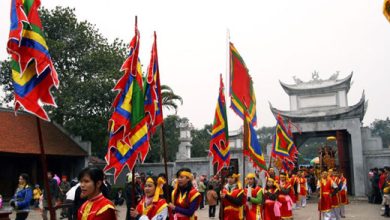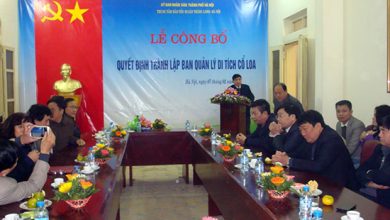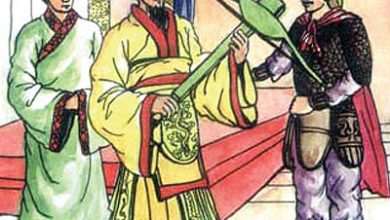Prehistoric Co Loa
According to archaeological researches, at the end of the Old Stone Age about 20,000 years to 11,000 years ago, there were vestiges of human habitation in Co Loa.
In 1971 – 1972, archaeologists found in Dong Thanh, Duong Ca (Main Road) area- also known as Duong Cam Xu (Forbidden Land Road) a few pebbles with traces of carving and processing by human hands. After expanding the searching area to Dam Ca, in Duong Bui and Duong Riu, archaeologists also found many similar pebbles. In March 1983, archaeologists found in Thu Cuu Mound in Cuu Hamlet some pebbles with traces of carving and processing. These tools are put into Son Vi culture by archaeologists.
Son Vi culture of Late Old Stone Age, was first discovered in Son Vi Commune, Lam Thao district, Phu Tho Province in 1968. The owners of Son Vi Culture resided in vast areas from Lao Cai, Son La and Lai Chau in Viet Bac, Tay Bac, through the hills of the provinces of Phu Tho, Bac Giang, Bac Ninh and Ba Vi (Ha Tay), Dong Anh (Hanoi) in the north, to Thanh Hoa, Nghe An, Ha Tinh, Quang Tri Provinces in Central Part and Lam Dong in the South. Then there were primitive groups who lived in limestone caves, but most of them lived outdoors, set up tents on hills and mounds, which were still jungles. Son Vi primitive people earned their living by hunting animals and picking fruits, in which the plant food was dominant. People also lived in groups; each group consisted of a number of families according to maternal line, etc.
But Son Vi primitive people did not have long-term stable living conditions on Co Loa mounds.
According to the Geography book of Co Loa, when primitive people were present in Co Loa, it was a period of marine transgression; the sea level rose and immersed low-lying areas in the south of Hanoi. Son Vi primitive people in Co Loa had to retreat to the foot of mountains in limestone caves or high shelves. During the Neolithic era, from about ten thousand years to approximately 4,000 years ago, Co Loa in particular and Hanoi in general was completely absent.
On the basis of stone processing technology developed to a high level, residents of the Neolithic era in our country found a new material, i.e. brass. One of the tribal groups was the owner of Phung Nguyen culture.
Phung Nguyen tribes were residents of rice agriculture in Phu Tho, Vinh Phuc, Bac Giang, Bac Ninh, Ha Tay, Hanoi, Hai Phong. Phung Nguyen tribes reached the pinnacle of stone processing techniques with the proficiency in using saws, drilling holes, splitting cores, grinding, etc. where people from all previous and later stages were insurmountable. Phung Nguyen residents were talented potters. They used turning tables to produce pottery of various kinds, designs and harmonious decorations. The traces of their residence are ancient villages, permanent settlement in an area of tens of thousands of square meters. Phung Nguyen residents knew how to breed dogs, pigs, cattle and chickens. They knew about the brass alloy and used brass alloy to manufacture production tools, but in fact these new tools were not so important in the economic and social life. Phung Nguyen tribes therefore were not beyond the category of primitive forms of communalism. However, it is worth noting that at this time due to the emergence of metallurgy that the man initially had an important position in the production and in social life. At the time of Phung Nguyen culture, the first germ of the patriarchal regime appeared in the heart of primitive society. In Phung Nguyen period, people still lived in primitive society, but Phung Nguyen primitive society was vigorous, rising to negation itself. It had all the premises to step into a new higher form – class differentiation society and primitive state.
Phung Nguyen primitive residents needed to expand the scope of survival. It was also true that at this time the sea level decreased, leaving behind a delta with a series of depressions, which were gradually consolidated into swamps and jungles by Red River alluvial sedimentation, waiting for the human beings to explore. Co Loa began with exciting human life again.
On the high promontory on the banks of Yellow River, archeology discovered relics of Dong Vong (Duc Tu), Bai Men (Co Loa), Dinh Trang (Duc Tu), Xuan Kieu, Lo Khe (Lien Ha) during Phung Nguyen period; vestiges of Tien Hoi, Bai Men, Dinh Trang (Following Phung Nguyen), Xuan Kieu vestiges of Dong Dau and Duong May stages (Co Loa), Dinh Trang vestiges in Dong Son period. In Co Loa, archeologists sometimes found Dong Son bronze artifacts such as arrows, plowshares, kettledrums, axes, etc. In Dong Son artifacts found in Co Loa, there are many very typical and valuable relics. Co Loa kettledrums Type I and Ngoc Lu and Hoang Ha kettledrums were nice and the earliest of its kind in Vietnam. Arrows and plowshares in large volume have characteristics of types and designs. Particularly, recently archaeologists found bronze three-side arrow molds in Thuong Temple which was the testament to the processing of Dong Son typical weapons right in the center of Co Loa.
The relics are the traces of villages settling and living by farming, fishing and hunting, which existed for a long time, developed continuously from the early Brass era to early Iron era, i.e. the foundation of the nation. Under the Chinese Han Dynasty, Co Loa belonged to Tay Vu District with 32,000 households, accounting for about 1/3 of Giao Chi county’s households (92,440 households) and nearly equal to the number of households in Cuu Chan District (35,743 households). Districts in the early Chinese Han Dynasty were largely set on the basis of Van Lang-Au Lac, corresponding to the “ancient tribes”. Before becoming the capital of Au Lac, Co Loa – Tay Vu was a fertile, crowded area which was like a residential, political, economical and cultural center of great importance of the country.





